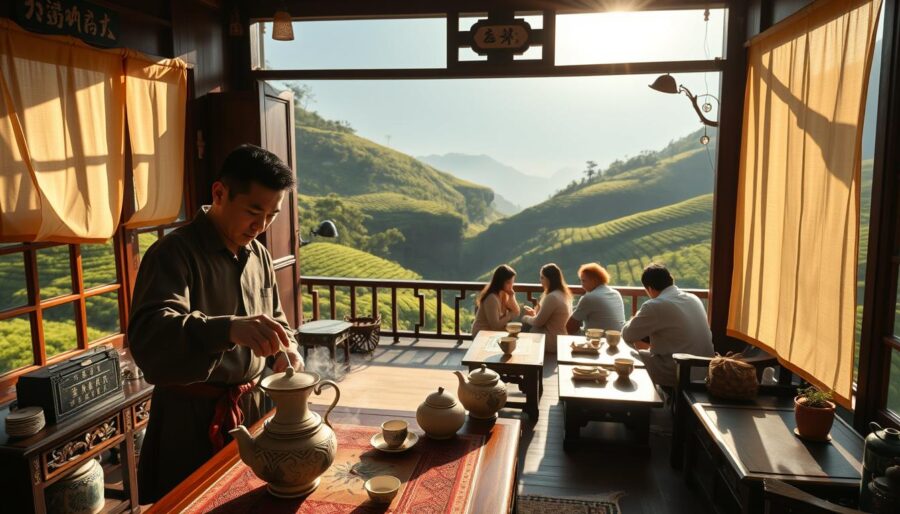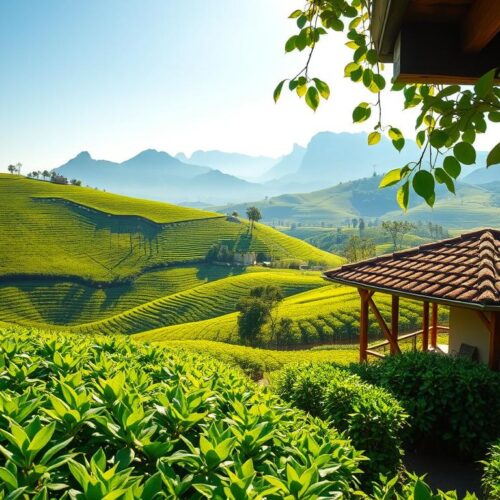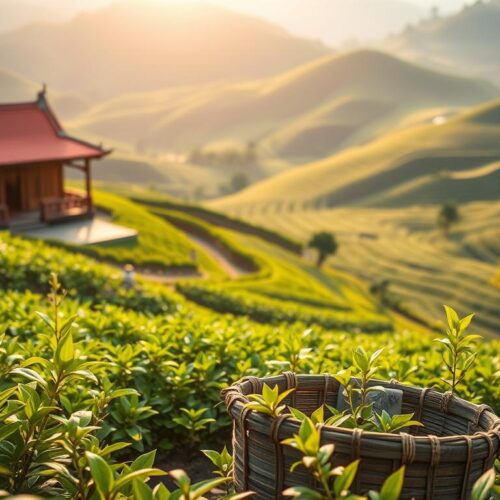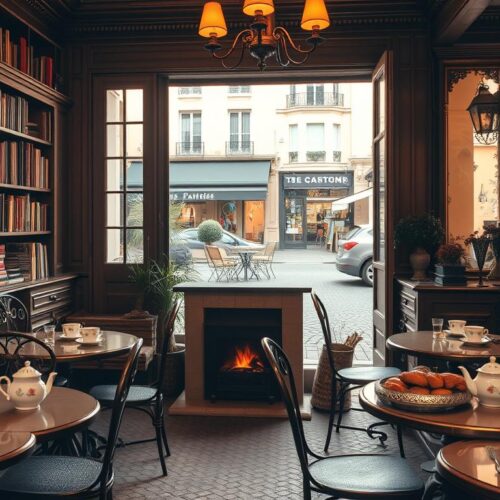Bubble tea is more than just fun. It started in Taiwan during the 1980s. Now, it’s everywhere from Los Angeles to New York. But there’s more to Taiwan’s tea culture, with its premium leaves, skilled roasting, and peaceful tea ceremonies.
Bubble tea combines tea, usually black, green, or oolong from Taiwan, with milk or a non-dairy option. It’s sweetened, chilled with ice, and gets its froth from a good shake. Then, you pick your sweet level and add-ins like tapioca or jelly. Places like Chun Shui Tang and Milksha have made customizing these drinks part of the daily routine.
Social media helped bubble tea become a worldwide hit. Flavors like fruit tea, brown sugar boba, and cheese foam became popular. Planning a trip to Taiwan for tea? You’ll see its rich culture in tranquil mountain tea farms and quaint tea rooms, not just trendy cafes.
This guide will show you the way. Discover the history, meet tea farmers, and understand why oolong tea is central to Taiwan’s culture. Travel from the Alishan mountains to Taipei’s tea spots. You’ll get a complete picture of Taiwan’s tea culture, far beyond the bubble tea you know and love.
From Street Sips to Tradition: The Bubble Tea Origin and Its Place in Taiwan tea culture
Bubble tea started in 1980s Taiwan with tea, milk, sugar, and tapioca pearls. Chun Shui Tang in Taichung sparked its fame and still draws crowds. The “bubble” in its name comes from the froth made when shaken, not the pearls.
The drink quickly became popular across East Asia in the 1990s and hit Western cities by the 2000s. Social media made it a global favorite by 2010. By 2015, variations with green tea and different sweeteners appeared. DIY kits became popular in 2020, and by 2023, bubble tea shops were everywhere.
In Taipei, bubble tea is part of the street culture. Stalls in Ximending offer endless new blends. Prices remain between 30–70 TWD, making it a daily treat for many.
Today’s brands keep the tradition alive. You find OOLONG TEA PROJECT and WOOTEA famous for their quality. Xing Fu Tang is known for its brown sugar pearls. Other shops like Tea Shop and KEBUKE are loved for their unique flavors and textures. They all link back to Taiwan’s tea culture.
Exploring Taiwan through tea lets you taste its history. Every bubble tea, from classic milk to oolong, tells part of Taiwan’s story. It’s an invitation to experience the island’s rich tea traditions.
Taiwanese Oolong Heritage: What Makes Oolong the Soul of the Island
Taiwanese oolong tea finds its unique spot between green and black teas. Its partial oxidation creates a complex taste—think orchid, honey, and stone fruit flavors. It has a bit of caffeine. This balance is central to Taiwan’s tea culture. The process of withering, bruising, and roasting elevates the tea’s quality and price. It also gives a clean, long-lasting taste.
Oolong tea has a lively feel in the cup. Hot brews share soft floral notes, while cold versions are juicy and bright. As you dive into Taiwan’s tea scene, you’ll see how artisans carefully control each step. They use bamboo drums to turn the leaves and gently coax out the aroma. This process avoids bitterness and gives a clear taste, even with little sugar.
As a modern drink base, oolong tea shines in bubble tea. Places like OOLONG TEA PROJECT and certain “teapresso” cafes show off fresh leaf jars and precise timing. Oolong adds more depth compared to black or jasmine green teas. This means you can enjoy a rich taste without it feeling too heavy.
The flavors paired with oolong tea are kept light to respect its aroma. Options like taro or matcha add an earthy elegance. Adjusting the sugar and ice just right highlights the tea. Toppings like grass jelly, egg pudding, aloe, or lychee jelly complement its texture. They let the floral tastes shine. This way, each sip offers character, not just sweetness.
Today’s tea scene blends tradition with the modern. In Taipei and Taichung, mountain-grown loose leaf tea is the heart of tea house rituals. The same leaves add life to modern cafes in trendy areas. Planning your tea travels in Taiwan might lead you on a quest. You’ll be searching for that unique lift found only in Taiwanese oolong. It connects you directly to the essence of Taiwan’s tea culture.
Alishan to the Highlands: Tea Terroir, Elevation, and Sun-Kissed Slopes
As you head up the road from Chiayi to Alishan, things change. The cooler air and misty clouds hug the hills. Here, tea bushes grow slowly, creating a special taste. This land gives Taiwanese oolong tea a creamy feel, bright sweetness, and gentle orchid flavor that stays with you.
The height of where tea grows affects its flavor. The mix of cool nights and warm days makes the tea leaves rich in taste. While traveling in Taiwan, you’ll see how being 1,000 to 2,000 meters up makes the tea taste better. This even applies to teas mixed with milk or fruit.
Where the tea garden faces and its slope are important too. South-facing gardens catch soft morning light. Then, the afternoon mist protects the young leaves. Each part of the highlands has its own unique conditions. This becomes clear when you try different teas right next to each other in Alishan.
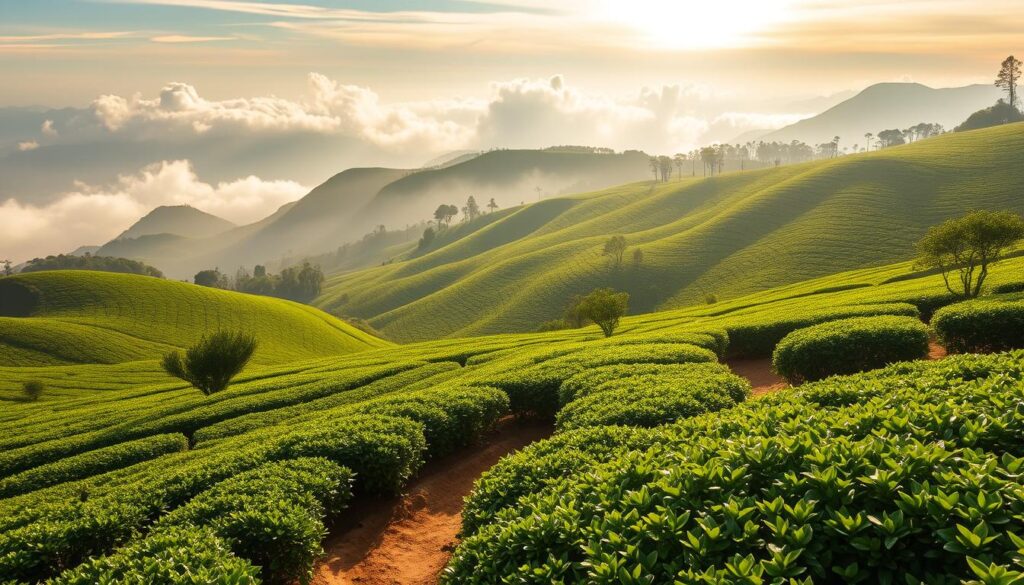
In Alishan, many travelers from the U.S. enjoy the forest railway, walking among cedars, and visiting farms. They also love tasting guided sessions. Shops in Taipei and Taichung now put Taiwanese oolong on their bubble tea menus. You can choose a specific place’s tea for flavors like lychee, peach, or mango. These choices add a special depth to the drink.
- Choose lower sugar to keep high-mountain florals vivid.
- Ask for light ice and no heavy cream caps to preserve texture.
- Request Taiwanese oolong by origin when you order fruit-forward drinks.
| Region | Typical Elevation (m) | Flavor Hallmarks | Best For |
|---|---|---|---|
| Alishan | 1,000–1,600 | Creamy body, orchid, sugarcane finish | Straight brews; low-sugar milk oolong |
| Shanlinxi | 1,200–1,800 | Green florals, pear, cool menthol lift | Fruit teas needing crisp structure |
| Lishan | 1,800–2,600 | High aroma, stone fruit, long aftertaste | Premium tasting flights |
| Dayuling | 2,200–2,600 | Focused minerality, alpine herbs | Neat oolong, no toppings |
When planning a tea tour in Taiwan, think about where the slope faces, the cloud patterns, and when they pick the tea. Tea picked in the morning from misty areas tends to be smoother. Tea from sunnier spots has a brighter taste. Starting with Alishan, each stop in the highlands adds a new layer to the island’s oolong variety.
Tea Farms and Field Experiences: Immersive Encounters with Growers
As you walk into the misty rows of tea farms, you watch oolong tea being made. The leaves go through many steps: they’re plucked, withered, lightly bruised, rolled, and dried. This whole process shows why oolong is a mix between green and black tea, showing the importance of local environment.
Make plans to explore Taiwan’s tea regions, like Alishan and its surrounding highlands. Try fresh high-mountain teas right where they’re made. Then, compare them to the teas in cities, including boba tea drinks. This experience sharpens your ability to taste differences at tea shops in Taipei and Taichung.
Workshops help you understand tea better. You get to smell dry tea, test water temperature, and see how roasting changes its flavor. From floral and creamy to sweet like honey and grainy. These skills help you choose the best boba tea ingredients, like the tea base and how much sugar or ice to add.
Link what you learn on farms to famous tea spots. Visit Chun Shui Tang in Taichung, the birthplace of boba tea. Or, go to Chicha San Chen to learn about different tea varieties and how they’re roasted. The staff there will help guide your choices.
In the U.S., try to schedule tea tastings for when your taste buds are most alert. Keep notes on the tea’s taste, sweetness level, and what kinds of toppings you add. After exploring Taiwanese tea for a week, you’ll start to notice patterns. This makes it easier to understand the tea culture in Taiwan, both on farms and in city tea shops.
Historic Tea Houses Taipei: Sipping Tradition in the Capital
Step into tea houses in Taipei to take it slow and discover the city’s heart. You’ll leave behind the busy Ximending boba spots for peaceful rooms. Here, kettles softly whistle, and tea leaves open up. Formal tastings let you sample different teas like roasted oolong and sun-dried black tea, showing Taiwan’s tea culture calmly.
Jiufen Old Street invites you to enjoy warm tea as mist floats by the windows on the hillside. The contrast is clear when you get a cold, shaken tea back in town. This blend of ancient and modern keeps you coming back to explore Taiwan’s tea scene.
In Taipei, you find both chain and independent tea spots. Try the famous black tea at SOMA, or enjoy KEBUKE’s café teas that focus on quality. Watch COMEBUYTEA make perfect “teapresso.” They show off whole leaves and make drinks to order, even for special teas like brown sugar boba and seasonal fruit blends.
Try a classic high-mountain oolong or tie guan yin with some roasted peanuts, mochi, or a flaky pastry. Some places offer tea-infused desserts like tie guan yin cream puffs, which match the floral notes in your tea. This combination creates a unique flavor experience to enjoy with each sip.
| Experience | What You’ll Taste | Setting | Why It Matters |
|---|---|---|---|
| Traditional Gongfu Service | Oolong flights, multiple steeps, evolving aromas | Quiet rooms with clay kettles and small cups | Shows nuance at different temperatures and times |
| Jiufen Old Street Teahouses | Hot oolong, black tea, light snacks | Hillside views, lantern-lit lanes | Links scenery to flavor memory in Taiwan tea culture |
| SOMA Black Tea Series | Robust, clean brews; balanced sweetness | Modern counters with bar-style service | Proves tea-first craft within a fast format |
| KEBUKE Café Concept | Leaf-driven blends, limited seasonal picks | Contemporary café seating | Highlights quality sourcing for tea travel Taiwan |
| COMEBUYTEA “Teapresso” | On-demand extraction for bold flavor | Visible machines and measured brews | Bridges espresso technique with tea houses Taipei |
| Pairings and Desserts | Tie guan yin cream puffs, mochi, pastries | Tea rooms and bakery crossovers | Extends tasting notes from cup to plate |
Beyond Bubble Tea: Styles, Bases, and Toppings That Define Modern Cups
First, you pick a base for your cup. Milk tea uses black, green, or Taiwanese oolong teas. Black tea is strong and malty. Green tea has a light, grassy flavor. Taiwanese oolong tea adds a floral touch and smooth ending. For fruit teas, jasmine green is common. There are also unique bases like yogurt, taro, or chocolate for a richer taste. Roasted grains give a toasty, nutty flavor, making your drink warm and comforting.
Then, you choose the flavor to set the mood. Vanilla, chocolate, or caramel offer classic sweetness. Fresh flavors like strawberry, mango, peach, kiwi, watermelon, and guava make your cup brighter. Taro and matcha bring an earthy elegance. North American favorites like peanut butter or cookies and cream turn your drink into a treat. They still keep the playful spirit of original bubble tea.
Toppings add different textures and surprises. Classic tapioca pearls provide a chewy feel. Brown sugar boba brings a caramelized scent. Cheese foam on top balances the fruit or sweet bases well. Choices like popping boba, fruit jellies, grass jelly, egg pudding, or aloe vera add contrast. Each bite changes the taste, keeping it interesting.
Customizing your drink is key. You pick how sweet or icy it is, the size of pearls, and whether it’s hot or cold. Drinks with layers—like milk over tea or syrup stripes—look great on Instagram. On tea trips in Taiwan, you see how the look of a drink hints at its taste even before you try it.
In different regions, bubble tea has its own twist. Southeast Asia loves durian and strong sweetness. Europe prefers soft flavors like Earl Grey, lavender, and rose. In Taiwan, top-quality teas, especially Taiwanese oolong, are highlighted at artisan shops. Travelers love Odd One Out in Taipei for its craft methods that honor tradition.
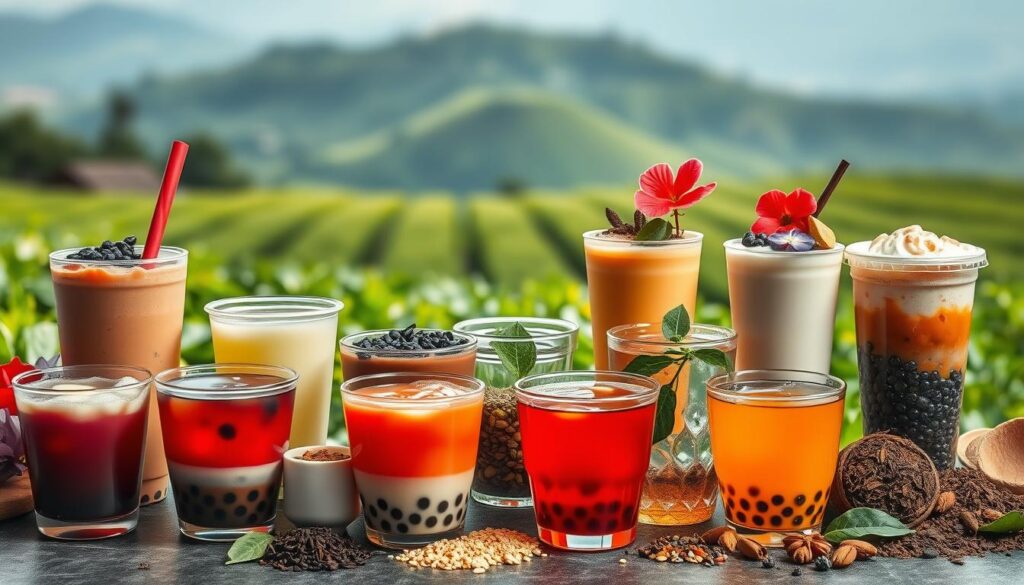
| Base | Flavor Profile | Best Pairings | Why It Works |
|---|---|---|---|
| Black Milk Tea | Robust, malty, deep | Brown sugar boba, cheese foam | Bold tannins cut through dairy and caramelized notes. |
| Green Milk Tea | Light, grassy, crisp | Aloe vera, fruit jellies | Clean finish balances juicy textures and bright add-ons. |
| Taiwanese Oolong | Floral, silky, layered | Egg pudding, grass jelly | Gentle aromatics complement creamy, subtle toppings. |
| Jasmine Fruit Tea | Fragrant, citrusy lift | Popping boba, mango or peach | Aromas amplify fruit acids and refreshing sweetness. |
| Taro or Matcha | Earthy, creamy, mellow | Tapioca pearls, caramel | Starchy depth pairs with chew and round sweetness. |
| Roasted Grain Infusion | Toasty, nutty, warm | Brown sugar boba, chocolate | Roast tones echo caramel and cocoa for harmony. |
Remember these styles when planning tea trips to Taiwan. They show you how the tradition influences each part of bubble tea. With Taiwanese oolong as a foundation, modern cups stay true to their heritage while exploring new tastes.
tea travel Taiwan: Planning Routes from City Tastings to Mountain Retreats
Start your tea journey in Taipei for a fun comparison of different teas. In Ximending, visit cool spots like OOLONG TEA PROJECT (Dejang 得正), WOOTEA, 50嵐, COMEBUYTEA, SOMA, and Like Tea Shop. Fans love the chewy pearls and strong tea taste, so try ordering with less sugar and ice.
Next, relax at Jiufen Old Street with traditional tea styles. Enjoy tea in Taipei’s tea houses with hot brews and amazing sea views. This mix of slow tea sipping and fast city life will improve your tea tasting skills.
Then, travel south to Taichung and stop by Chun Shui Tang, where bubble tea started. Don’t miss Chicha San Chen’s flagship store to learn about different roast levels and tea brewing. Keep track of your tea preferences through notes on sweetness, ice, and toppings.
In Alishan, explore tea farms, taste directly from the sources, and learn about tea-growing areas. Book these sessions in the morning when you can taste better. Choosing drinks with less sugar will highlight the special flavors of high-mountain oolong tea.
When budgeting, remember most teas cost between 30–70 TWD. Look for unique flavors that showcase Taiwan’s local fruits and tea types. If you’re from the U.S., check out tea brands like KOI from 50嵐, KEBUKE, and Wushiland Boba. Read social media reviews to find spots with fresh tea and perfectly textured pearls.
| Stop | What to Try | Why It Matters | Pro Tip |
|---|---|---|---|
| Taipei (Ximending) | OOLONG TEA PROJECT, WOOTEA, 50嵐, COMEBUYTEA, SOMA, Like Tea Shop | High variety for side-by-side tastings | Order less ice, 30% sugar to gauge base strength |
| Jiufen Old Street | Hot oolong at tea houses Taipei with view | Slow brewing highlights aroma and finish | Pair with light snacks to avoid palate fatigue |
| Taichung | Chun Shui Tang; Chicha San Chen flagship | Historic bubble tea roots and precision brewing | Compare roast levels across the same tea base |
| Alishan Highlands | Farm tastings and field tours | Terroir education and fresh-picked nuance | Morning sessions; minimal sugar to taste florals |
| U.S. Connections | KOI (from 50嵐), KEBUKE, Wushiland Boba | Extend learnings after the trip | Seek shops brewing to order for consistency |
- Daily budget: plan for several cups at 30–70 TWD each.
- Log each drink: base, sugar, ice, toppings, and tasting notes.
- Chase seasonal picks to sample rare leaves and local fruit.
- Schedule city tastings before meals and Alishan farm tours early.
Bubble Tea as Cultural Bridge: From Taiwan Streets to the U.S. Scene
Imagine a cup’s journey across the globe. It started in Taiwan in the late 20th century. By the 1990s, East Asia had fallen in love with it. The 2000s saw cities like Los Angeles and New York making it a part of their daily lives. It connected people to Taiwan’s tea culture without needing to travel there.
The drink became a social media star next. Instagram and TikTok made it famous worldwide. People used hashtags like #BubbleTea to share their favorite finds. This was often their introduction to Taiwan’s tea culture.
In North America, the flavors are bold and sweet, like peanut butter or cookies & cream. But the essence of tea remains strong, thanks to black and oolong teas. Spotting a Wushiland Boba means you’re tasting authentic Taiwanese ingredients.
Bubble tea shops are more than just places to drink. They let you customize your order and try new things. In 2020, people started making bubble tea at home with DIY kits. This helped them understand and appreciate its origins.
Coming back from Taiwan, your ordering skills will be sharpened. You’ll choose your tea base carefully and specify how sweet you want it. Your choices help support Taiwanese-owned businesses. And they keep the tradition of prioritizing tea alive in your city.
| Era | Milestone | U.S./Canada Hotspots | Signature Traits | Cultural Impact |
|---|---|---|---|---|
| 1990s | East Asia adoption after the bubble tea origin | — | Classic milk tea, chewy tapioca | Introduces Taiwan tea culture to regional youth |
| 2000s | North American spread | Los Angeles, San Francisco, New York City, Toronto, Vancouver | Tea-first menus, early toppings variety | Boba shops emerge as cross-cultural hangouts |
| 2010–Present | Social media boom | Major metros and college towns | Instagrammable layers, TikTok challenges | Global visibility fuels tea travel Taiwan and brand growth |
| Today | Authenticity and innovation | U.S. outposts like Wushiland Boba | Strong black/oolong bases, dessert spins | Personalized orders connect daily life to Taiwan tea culture |
Conclusion
Your journey through Taiwan tea culture begins with bubble tea from Taichung. It quickly became a worldwide favorite in the 1980s. But there’s more to explore—kettles, gardens, and quiet rooms where Taiwanese oolong shares its floral secrets. You’ll discover how Alishan’s mountains, tea harvest timings, and careful roasting influence the taste.
Today’s menus add new twists to these traditions. You can pick from black, green, or oolong tea, and fruity or creamy bases. Then, add pearls, boba, or jellies as you like. Remember, choosing less sugar keeps oolong’s light flavor, and too much ice can dull it. In the U.S., good tea shops show real tea leaves, have balanced toppings, and use “teapresso” machines. This shows how tea connects places from Los Angeles to New York.
When planning a tea trip in Taiwan, make it meaningful. Visit tea spots in Taipei, the bubble tea birthplace in Taichung, and enjoy Alishan’s scenic hikes. Note the prices and flavors, around 30–70 TWD, and make a flavor guide. This guide—tracking roast, origin, and strength—will help you choose the perfect tea anywhere.
Take your tea experience back home. Mix a refreshing bubble tea or enjoy a detailed gongfu tea session. Your drink choices reflect what you’ve learned from the mountains to the cities. This makes tea travel in Taiwan a lasting tradition. And with every sip, you continue to tell your unique story of Taiwan’s tea culture.

